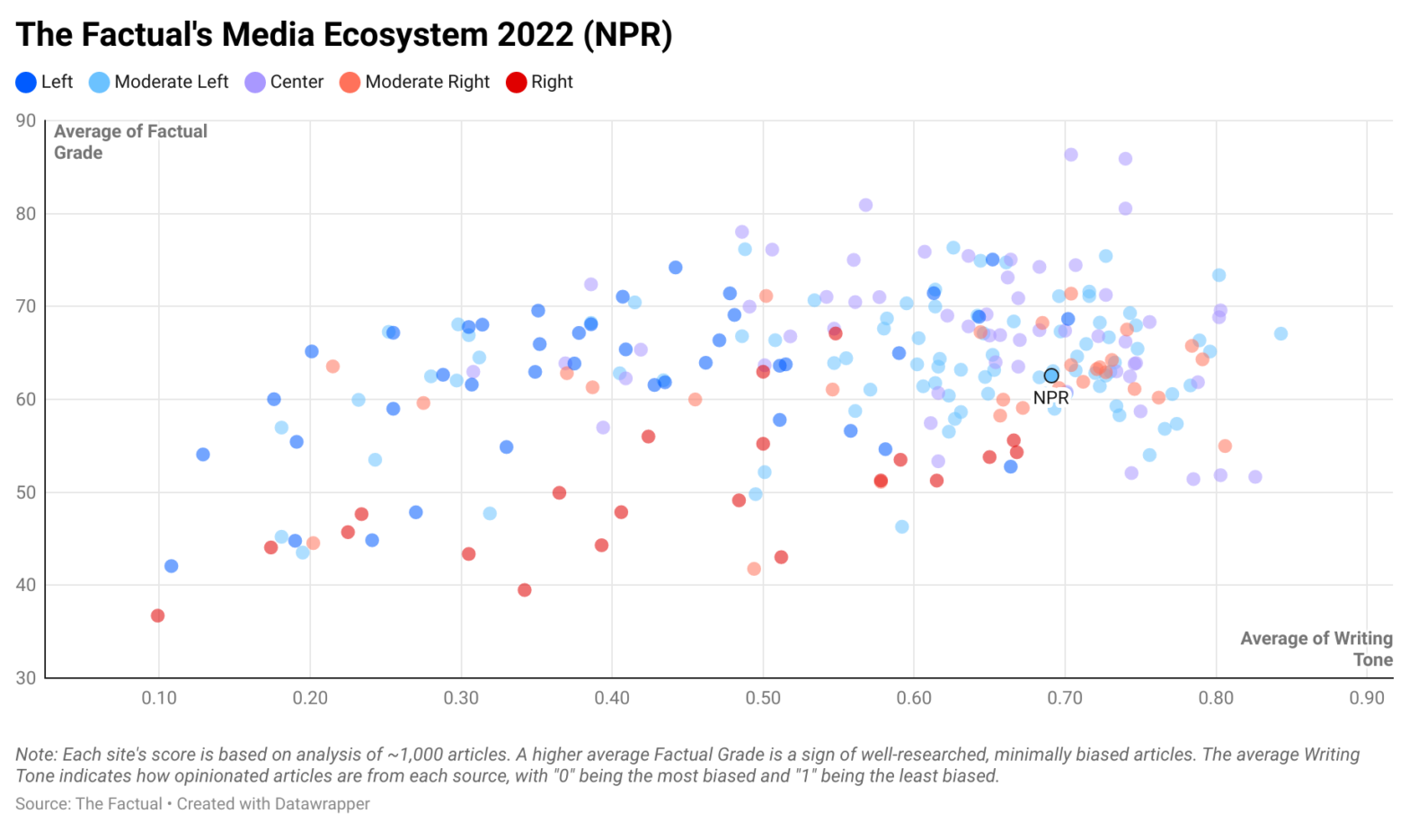NPR, or National Public Radio, is one of the most prolific news sources in the U.S., with over 1,000 public radio stations across the nation and a very popular news website. However, at times NPR has been accused of having a liberal bias. So, how reliable is NPR and how biased is its news content?
Note: This analysis is based on NPR’s online news content only.
How Does The Factual Rate News Sources?
The Factual analyzes more than 10,000 news stories every day to help readers find the most informative, least-biased articles. Our news-rating algorithm scores each article along four metrics: (1) cited sources and quotes, (2) publication history, (3) writing tone, and (4) author expertise. These scores combine in a weighted average we call a Factual Grade, which ranges from 0–100%. (See our How It Works page to learn more about our algorithm.)
For this study, we analyzed ~1,000 articles each from 240 news sources. The average Factual Grade for the entire dataset was 62.5%. Based on these averages, we can compare the performance of news sites across the media ecosystem. The entire dataset can be explored in greater detail here.
How Factual Is NPR?
NPR scored an average Factual Grade of 62.6%, placing it in the 42nd percentile of our dataset. These moderate scores can be explained by a range of practices. For example, NPR maintains fairly consistent practices of sourcing information, meaning stories usually include links to high-quality external sources or direct quotes. Likewise, our data suggests that NPR stories usually incorporate fairly unbiased language (more on this below). However, scores are dragged downwards by the author expertise metric. While the publisher employs a number of experienced journalists who routinely cover the same topic areas, there are many articles which lack an identifiable author.
Like any news source, scores for articles from NPR varied widely based on factors like author expertise and cited evidence. For example, some scored above 90%, while others scored below 50%.
Please check your email for instructions to ensure that the newsletter arrives in your inbox tomorrow.
How Opinionated Is NPR?
One of the metrics The Factual uses is the Writing Tone, which measures how opinionated the writing is in an article. For this metric, the algorithm looks for signs of subjective commentary (e.g., first person pronouns and unnecessary adverbs), as well as the emotional nature of selected words, and sees how prevalent they are for a given length of text. More neutral text receives higher ratings, with “0” being the most opinionated and “1” being the most neutral.
NPR had an average Writing Tone score of 0.69, placing it in the 70th percentile in our dataset for this metric. This suggests that articles from NPR are generally written in a neutral tone, meaning they are written to convey information rather than elicit an emotional response. This can be seen in neutrally worded headlines such as “Life expectancy in the U.S. continues to drop, driven by COVID-19” and “Early signs suggest monkeypox may be slowing in the U.S.“
How Biased Is NPR?
The Factual classifies news sites by political bias as either Left, Moderate Left, Center, Moderate Right, or Right. This classification comes from third-party assessments from media bias organizations such as AllSides and Media Bias/Fact Check (MBFC). Based on this data, The Factual assigns NPR a Moderate Left bias.
AllSides rates NPR as having a “Lean-Left” bias based on results of editorial reviews, numerous blind bias surveys, independent research, and more than 60,000 community ratings. Prior to February 2022, the site was rated as “Center,” but AllSides adjusted the classification based on the results of a recent blind bias survey. Among 600 respondents, 71% rated the site as left of center. This represents a change from an editorial review from October 2021, when AllSides decided to maintain NPR’s “Center” rating, noting that NPR routinely fell on the border between “Center” and “Lean-Left.”
MBFC rates NPR as “Left-Center” based on “story selection that leans slightly left.” They also give the site credit for thorough sourcing of information and highly factual reporting. Overall, MBFC noted a tendency to favor some left-leaning perspectives through headlines and story selection.
Conservative sources argue NPR has a liberal bias, as demonstrated by its decision to permit its reporters to “participate in activities that advocate for ‘the freedom and dignity of human beings’ on both social media and in real life.” Others have labeled it a “Democrat Party propaganda operation” and continuously questioned the organization’s continued federal funding, though that accounts for only 1% of NPR’s budget.
Who Funds NPR?
NPR receives funding from a range of sources. According to Influence Watch, an online monitor of public policy influence, in 2017, the media outlet “earned 38% of its revenue from individual contributions; 19% from corporate sponsorship and licensing; 10% from foundation donations; 10% from university licensing and donations; 8% from the Corporation for Public Broadcasting; and 4% from federal, state, and local governments via member stations.”
Please check your email for instructions to ensure that the newsletter arrives in your inbox tomorrow.
How to Mitigate Bias
News articles are bound to have bias because all authors have some frame of reference within which they describe a story. Political bias ratings are helpful in understanding this framing. However, it can be more beneficial to know how factual an article is based on quantifiable metrics that can be seen across the media ecosystem, such as cited evidence, author expertise, and writing tone. This is what The Factual ascertains.
Reading several, highly rated articles from across the political spectrum helps counter the bias of any news source or story. To have the day’s most factual news stories delivered to your inbox every morning, subscribe to our daily newsletter.
Article published on September 21, 2022 to reflect new data.

